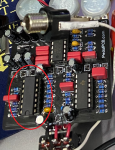If voltage measurements are required, please let me know. I'm doing some initial troubleshooting and figured I'd ask for guidance.
The pedal is not completely working when engaged. If all knobs are maxed there is a slapback like affect, but the LED is not on or blinking. While turning the Rate knob I did notice that the LED briefly came on, but wasn't able to repeat this.
It seems like the Dimension, intensity, Animate, and Depth knobs all have some level of functionality where as Shape and Rate do not. Am I correct in thinking I need to be looking at the section of items that are connected to the LM324? Any further direction would be fantastic.
The pedal is not completely working when engaged. If all knobs are maxed there is a slapback like affect, but the LED is not on or blinking. While turning the Rate knob I did notice that the LED briefly came on, but wasn't able to repeat this.
It seems like the Dimension, intensity, Animate, and Depth knobs all have some level of functionality where as Shape and Rate do not. Am I correct in thinking I need to be looking at the section of items that are connected to the LM324? Any further direction would be fantastic.

